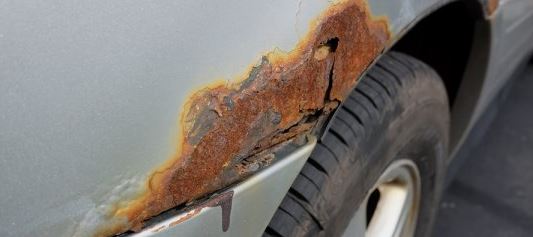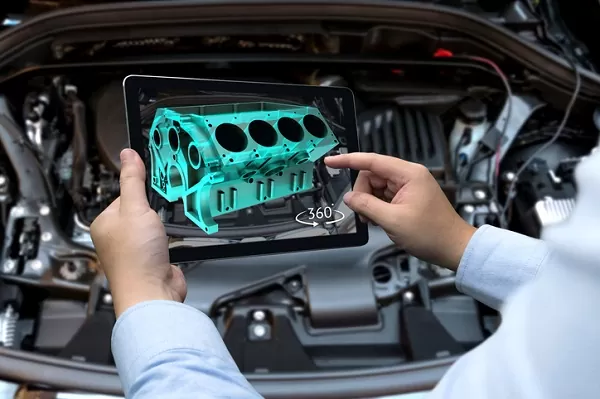Rust is a common problem that can affect cars in a number of ways. It can cause serious damage if left untreated, and it’s important to understand how rust forms and spreads so you can take steps to prevent it from happening. In this blog post, we’ll discuss the different types of rust, how it affects cars, and what you can do to remove or repair it. We’ll also give some tips on how to prevent rust from forming in the first place.
Let’s take a look!
What Is Rust On A Car?
When your car starts to develop rust, it can be a cause for concern. Not only is rust unsightly, but it can also lead to more serious problems down the road. So what exactly is rust and what causes it to form on your car?
Rust is simply iron oxide, which forms when iron or steel is exposed to oxygen and moisture. When these conditions are present, the iron will start to corrode, and eventually, this corrosion will turn into rust.
There are three main types of rust you can encounter: surface rusting, penetrative rusting, and scale rusting.
Surface Rusting:
This is the most common type of rust and happens when the protective coating on the iron or steel is damaged, exposing the metal underneath. Surface rust can often be removed with a wire brush or sandpaper.
Penetrative Rusting:
This type of rust happens when the corrosion penetrates deep into the metal, causing it to weaken. Once penetrative rust has started, it can be very difficult to stop and will eventually lead to the metal crumbling away.
Scale Rusting:
This type of rust is usually found on older cars that have not been properly maintained. Scale rust occurs when a build-up of dust and grime on the surface of the metal prevents oxygen from reaching the iron underneath. This causes the iron to corrode and eventually turn into rust. Scale rust is often very difficult to remove and can cause serious damage to the car.
What Are Some Common Rust Locations On A Car?
Rust can occur on any part of the car, but there are some areas that are more susceptible to rust than others. The most common rust locations on a car are:
-The doors: Rust often forms around the door handles and hinges. This is because these areas are exposed to the elements and get wet frequently.
-The fenders: Fenders are another area that is exposed to the elements and gets wet frequently. This makes them susceptible to rusting.
-The trunk: The trunk is another area of the car that is susceptible to rusting. This is because it is often exposed to moisture from rain and snow.
-The underbody: The underbody of the car is another area that is susceptible to rusting. This is because it is constantly exposed to moisture and salt from the roads
How Does Rust Affect A Car?
Rust is a serious problem for cars. It can cause all sorts of problems, from cosmetic damage to structural integrity issues. Let’s take a look at some of the ways rust can affect a car:
1. Rust can cause cosmetic damage.
This is the most visible way that rust can affect a car. Rust can cause unsightly staining, pitting, and flaking of the paint surface. In extreme cases, it can even eat through the metal itself, causing holes and bare spots. This damage can devalue your car significantly and make it more difficult to sell in the future.
2. Rust can cause structural damage.
While cosmetic damage is certainly an issue, rust can also cause serious structural damage to your car. Rust weaken the metal, making it more susceptible to impact damage and even failure. This can be extremely dangerous, as a weakened car frame can collapse in a collision.
3. Rust can cause mechanical problems.
Rust can also cause problems with your car’s mechanical components. rust can build up on gears, bearings, and other moving parts, causing them to seize up or break down completely. This can lead to expensive repairs or even render your car undrivable.
4. Rust can cause electrical problems.
Lastly, rust can cause electrical problems in your car. rust can conduct electricity, which can short out wiring and create all sorts of havoc in your vehicle’s electrical system.
How Fast Does Rust Spread On A Car?
There are many factors that can affect the speed at which rust spreads on a car. These include the type of metal the car is made from, the environment the car is stored in, and even the type of paint or other coating that is on the car.
One of the most important factors in how fast rust will spread on a car is the type of metal that the car is made from. Iron and steel are both metals that are very susceptible to rusting, especially when exposed to moisture. Aluminum and stainless steel are much more resistant to rusting, but they can still corrode under certain conditions.
Another important factor in how fast rust will spread on a car is the environment that the car is stored in. If a car is stored in an area that is high in humidity, or if it is regularly exposed to salt water or other corrosive materials, the rate of corrosion will be increased.
Finally, the type of paint or other coating on a car can also affect how fast rust will spread. If a car has a paint job that is not properly sealed, or if there are any bare metal areas exposed, rust can begin to form much more quickly.
In general, rust will spread more quickly on a car that is made from iron or steel, that is stored in a humid or corrosive environment, and that has bare metal areas exposed. However, there are many products available that can help to slow the rate of corrosion, and even prevent car rust from forming in the first place.
How To Repair Rusting On A Car
When it comes to rust, there are a few things that you need to know in order to properly repair it. The first is that there are three different types of rust: light surface rust, heavy surface rust, and deep rust. Each type of rust requires a different approach when it comes to repair.
Light Surface Rust:
This is the most common type of rust and is usually found on the surface of the metal. It’s important to note that this type of rust can easily spread if left untreated. To repair light surface rust, you’ll need to sand down the affected area until the metal is smooth. Once you’ve sanded down the area, you’ll need to apply a primer before painting over the area.
Heavy Surface Rust:
This type of rust is more serious than light surface rust and can cause major damage to your car if left untreated. Heavy surface rust usually forms in layers and can be difficult to remove. To repair heavy surface rust, you’ll need to sand down the affected area until the metal is smooth. Once you’ve sanded down the area, you’ll need to apply a primer before painting over the area.
Deep Rust:
This is the most serious type of rust and can cause significant damage to your car if left untreated. Deep rust usually forms beneath the surface of the metal and can be difficult to remove. To repair deep rust, you’ll need to sand down the affected area until the metal is smooth. Once you’ve sanded down the area, you’ll need to apply a primer before painting over the area.
How To Prevent Rusting On A Car
If you’re like most car owners, you don’t give much thought to rust prevention until it’s too late. By then, it’s often too late to do anything about it except for expensive repairs.
Don’t let your car become a rusty mess! Follow these simple tips and you can keep your car looking like new for years to come.
1. Keep your car clean
This may seem obvious, but it’s worth repeating. A clean car is a happy car! Washing your car regularly will remove any dirt, grime or salt that could lead to rust formation.
2. Apply a wax or sealant
A good coat of wax or sealant will create a barrier between your car’s paint and the elements. This will help to protect your car’s finish from rust-inducing moisture.
3. Inspect your car regularly
If you catch rust early, you can often stop it in its tracks before it does serious damage. Check your car for any signs of rust on a regular basis, and address any problem areas immediately.
4. Store your car properly
If you’re not going to be driving your car for a while, make sure to store it in a cool, dry place. Exposure to extreme heat or cold can accelerate the formation of rust.
5. Protect your car’s undercarriage
The underside of your car is especially vulnerable to rust formation. If possible, park in a garage or carport to protect your car from the elements.
6. Use rust-resistant materials
If you’re doing any work on your car that involves exposed metal, be sure to use rust-resistant materials. This will help to prevent any new rust from forming.
7. Keep your car dry
Water is one of the biggest enemies of a rust-free car. If your car gets wet, be sure to dry it off as soon as possible. Moisture trapped against the metal surface can lead to corrosion and rust formation.
8. Avoid road salt
If you live in an area where roads are regularly treated with salt, take extra care to protect your car from corrosion. Wash your car more often, and consider using rust-resistant undercoating.
9. Treat problem areas immediately
If you do find rust on your car, don’t wait to take care of it. The sooner you treat the problem, the less damage it will do. There are a number of products on the market that can remove rust and protect your car from further corrosion.
By following these simple tips, you can keep your car looking like new for years to come. Rust prevention is easy when you know what to do!











